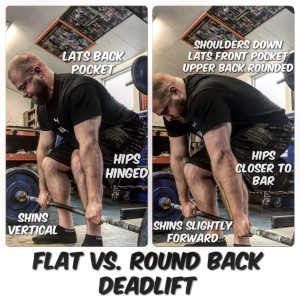The flat back deadlift is the standard technique most people use, or strive to. By pulling your lats back, taking the slack out of the bar and making a proud chest, you’re able to maintain a nice straight back position.
The lats back (flat back) position is difficult to maintain with heavy weight.
The round back deadlift is great for more advanced lifters wanting to move really heavy weight.
Start with your upper back rounded and keep a neutral low back position.
With the round back deadlift you start with your shoulders down and lats in the front pocket — a much easier position to maintain and allows you to shorten the ROM.
You’re able to get your hips closer to the bar, putting them in a stronger position with a shorter ROM. Your shins will be a little more forward for more quad involvement and a more explosive push off the floor.
It’s extremely important to breathe and brace properly when using this technique as you’re already starting in a more rounded position, and you want to prevent further rounding.
If you’re an advanced powerlifter/strongman looking to move as much weight as possible, the round back deadlift is generally the stronger option.
If you haven’t mastered the ability to breathe, brace, and develop tremendous tension through your body, or if the extra pounds aren’t that important, the flat back deadlift is generally the safer choice.
Here’s a comprehensive deadlift tutorial explaining both the flat and round back deadlift technique.
Want a bigger deadlift?
Shoot me an email at adamnpine@gmail.com with “DEADLIFT” in the subject line!


